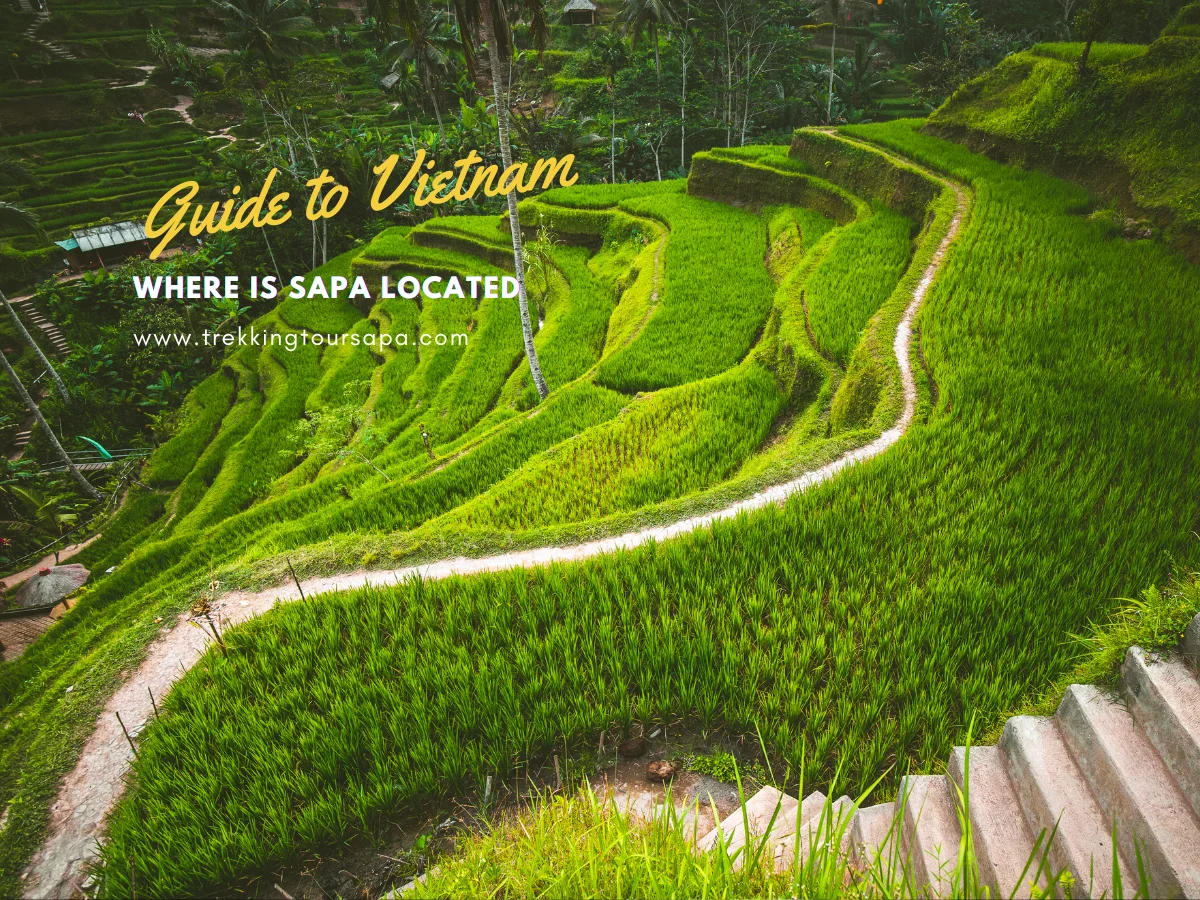Sapa is a beautiful town in northern Vietnam’s mountains. It’s a top spot for travelers from all over. The town is known for its stunning views and diverse cultures. If you’re curious about Sapa’s location, this article will show you its geography, culture, and attractions.
From the calm rice fields to lively festivals, Sapa is a must-see. It’s a favorite among those who love adventure.
As we explore Sapa, we’ll look at the Sapa Vietnam map. We’ll cover travel tips and food, giving you a full picture of Sapa’s charm.
Where Is Sapa Located Key Takeaways
- Sapa is situated in the northwestern mountainous region of Vietnam.
- It is recognized as the most beautiful town in Lao Cai Province.
- Home to various ethnic groups, including the Hmong, Dao, and Tay people.
- The best times to visit are between March to May and September to November.
- Fansipan mountain nearby, standing at 3,143 meters, is known as the “Roof of Indochina.”
- Sapa offers diverse trekking trails suitable for different skill levels.
- Local markets provide an immersive experience into the unique culture of the area.
Table of Contents
ToggleIntroduction to Sapa Town
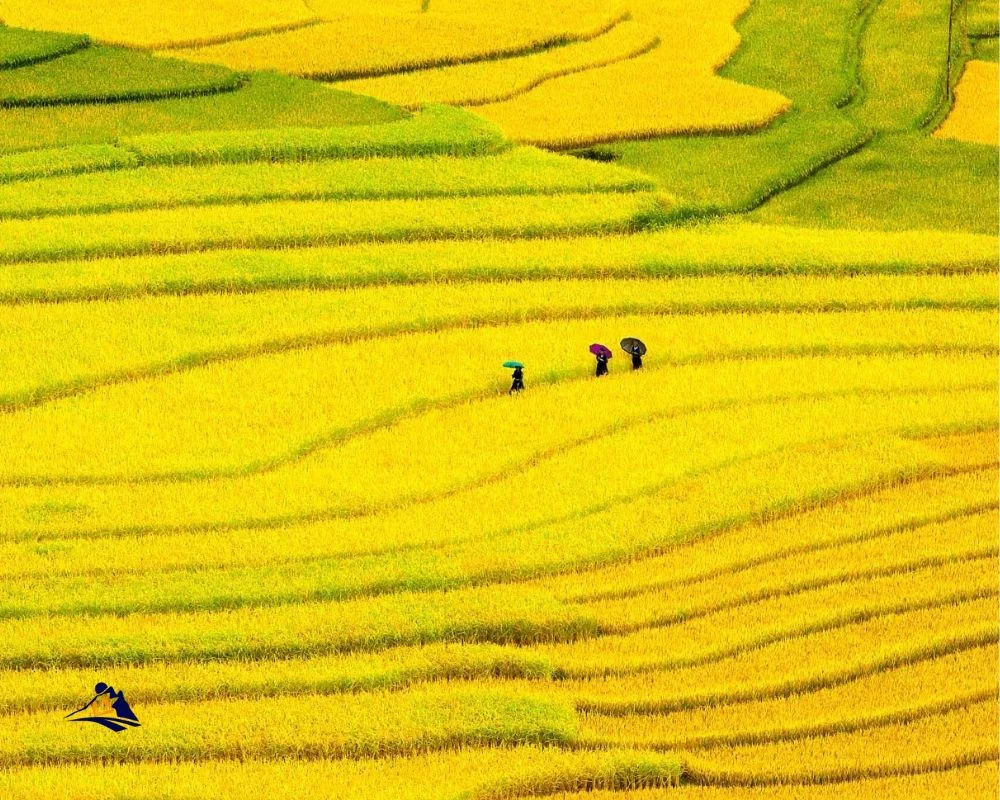
Sapa Town is in the heart of Lao Cai Province, Vietnam. It’s a place of enchantment for all who visit. With its stunning terraced fields and breathtaking views, it’s a gem. The town’s altitude of 1,650 meters in the Hoang Lien Son mountains adds to its charm.
The climate here varies from -1˚C to 29˚C. This shows the beauty of Sapa in every season.
The local culture in Sapa is vibrant and diverse. It’s shaped by ethnic groups like the H’mong, Dao, Tày, and more. Their traditions add to the town’s lively atmosphere.
Visitors love the handmade indigo clothing of the H’mong. They also enjoy the local customs.
The weather in Sapa is unique. It has cool mornings, warm days, and chilly nights. This makes every moment special.
Whether trekking, visiting markets, or enjoying the views, Sapa is unforgettable. It’s a journey into nature and culture.
Overview of Sapa’s Geography
Sapa is in northern Vietnam, near the Chinese border. It’s known for its Sapa geography and mountainous regions. The Hoang Lien Son Mountain Range surrounds it, with Fanispan, the highest peak in Indochina, standing at 3,147.3 meters.

The Sapa Vietnam map shows its rugged terrain. It has steep mountains, lush hills, and vibrant rice terraces. These features blend beautifully with the valleys.
Sapa’s climate changes with the seasons. It has spring, summer, autumn, and winter. The average elevation is about 1,500 meters, making summers cool for trekking.
From March to May, temperatures are between 15°C and 25°C. In September and October, the rice fields turn golden, a sight to see.
Winter, from December to February, turns Sapa into a winter wonderland. It sometimes snows, adding to its charm. This makes Sapa a beautiful place all year.
The O Quy Ho Pass and Silver Waterfall add to its beauty. They offer amazing views that change with the seasons.
Sapa is not just about its scenery. It’s also home to many ethnic minority groups, like the Hmong and Dao. Exploring Sapa, we can enjoy its beauty and learn about its culture.
Where Is Sapa Located?
Sapa is a beautiful hill station in Vietnam’s northwestern part. It’s known for its stunning views, diverse ethnic groups, and rich culture. Located about 300 kilometers north of Hanoi, Sapa has a unique climate and geography.
Sapa’s Location in Vietnam
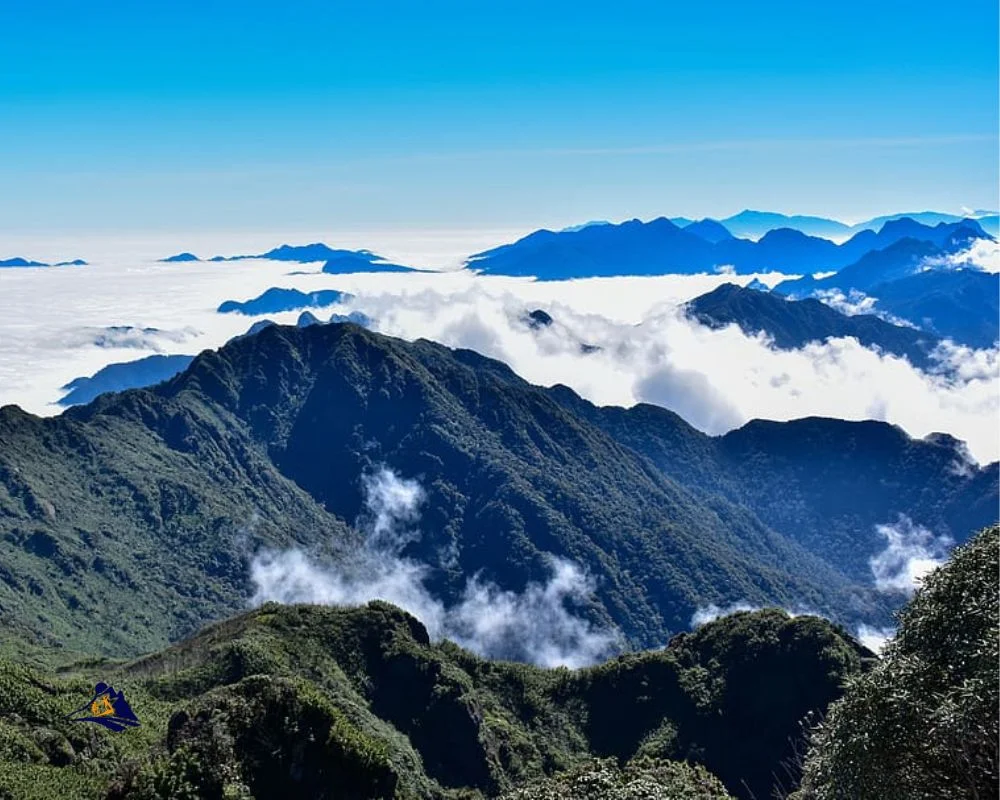
Sapa is near the border with China. This makes it a place where cultures blend. The town is surrounded by the Hoang Lien Son mountains and is close to Fansipan Mountain, Vietnam’s highest peak.
Sapa is also easy to get to by train or bus. This makes it a popular spot for travelers.
Neighborhood Geographic Features
The geography of Sapa is varied and beautiful. Terraced rice fields cover the hills, changing with the seasons. Cat Cat Village, a Hmong community, is just three kilometers away.
The ancient rock field is a national historical site. It has over 200 large boulders with carvings from 2,500 years ago. The Hoang Lien National Park is also nearby, showcasing the area’s wildlife and plants.
Why Sapa is Considered a Hidden Gem
Sapa is a top pick for Vietnam’s hidden gems. It offers a breathtaking escape from the usual tourist spots. Despite its fame, Sapa still holds a secret charm, making it a standout destination.
The landscapes in Sapa are perfect for adventure. Hiking through rice terraces shows off incredible views. Climbing Mt. Fansipan lets us see the clouds up close. We also find ancient rock carvings that share stories of the past.
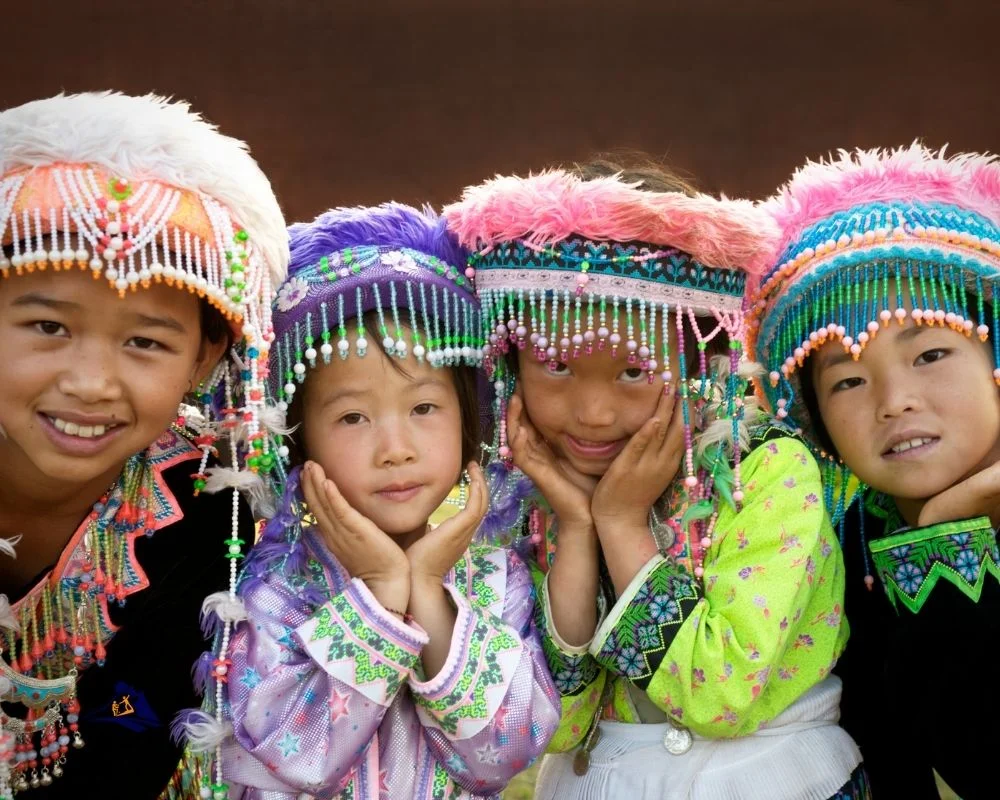
Meeting the local ethnic groups is a highlight. We learn about their traditions and ways of life. Each village, like Cát Cát and Tả Van, offers unique experiences for just 70,000 VND.
The markets in Sapa are full of local crafts and food. Visiting Bac Ha Market on Sundays lets us dive into the culture and try tasty dishes.
In summary, Sapa’s untouched beauty, rich culture, and varied activities make it a true gem in Vietnam.
Sapa’s Coordinates and Elevation
Sapa is in Vietnam’s northwestern region, known for its stunning views and cool climate. It’s at about 22.34° N latitude and 104.07° E longitude. This location makes Sapa a unique place to visit.
The town sits at an average elevation of 1,500 meters. This makes it one of Vietnam’s highest towns.
Geographic Coordinates
The high elevation of Sapa offers breathtaking views and a cooler climate. It’s close to cultural and natural sites, making it a favorite among travelers. For more details, check out this source.
The area is surrounded by mountains, valleys, and ethnic villages. It promises an unforgettable experience for all who visit.
Sapa 1 Day Tours
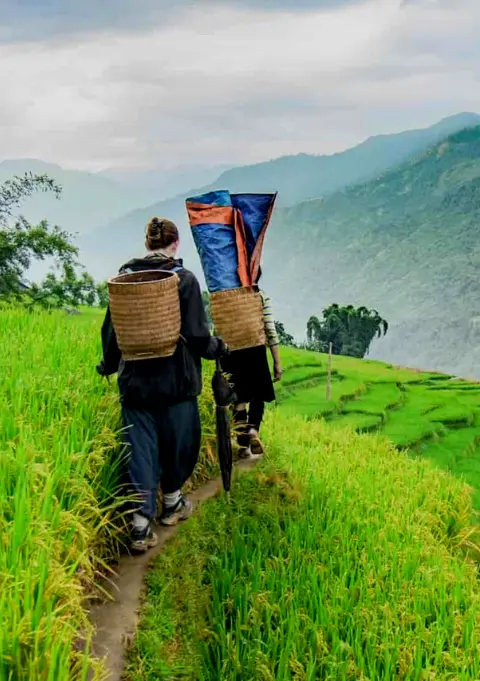
- 1 day experience
- Moderate to challenging
- Cultural immersion & active adventure
- Rice fields, valleys & villages
- Private tours
- Vegan-friendly
Sapa 2 Day Tours
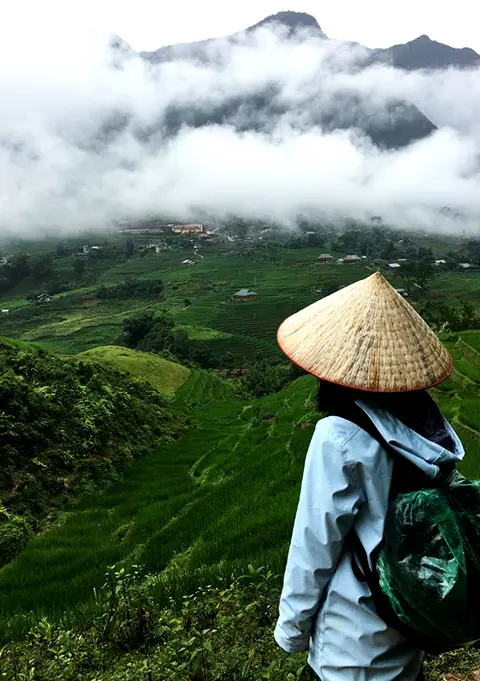
- 2 days 1 night experience
- Moderate to challenging
- Cultural immersion & active adventure
- Mountains, valleys, rice fields and villages
- Private tours
- Vegan-friendly
Sapa 3 Day Tours
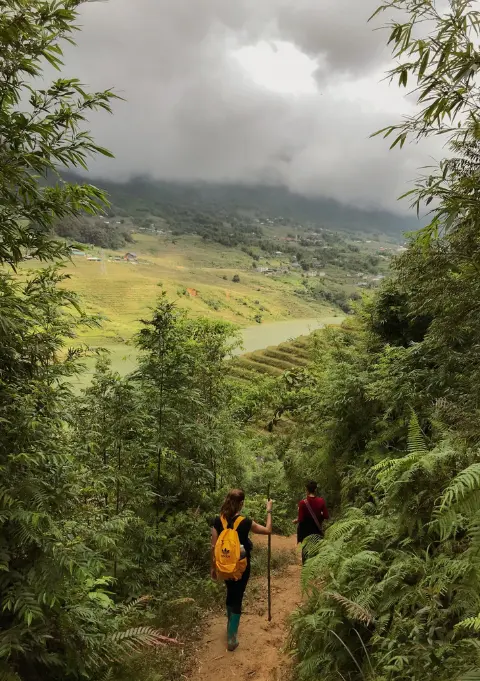
- 3 days 2 night experience
- Moderate to challenging
- Cultural immersion & active adventure
- Mountains, valley, rice fields & villages
- Private tours
- Vegan-friendly
Sapa 4 Day Tours
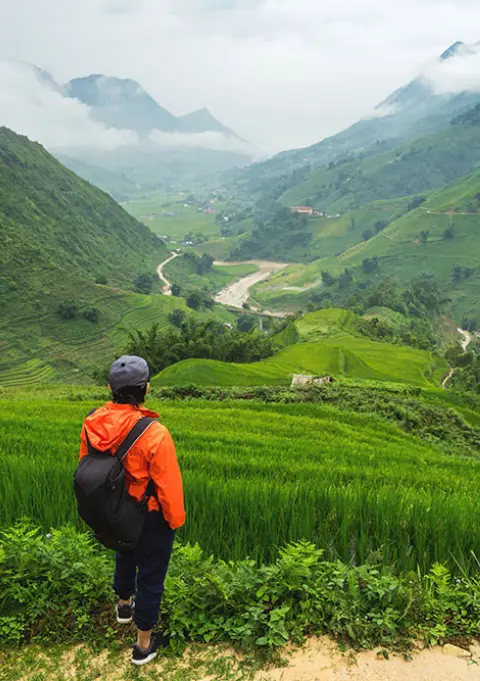
- 4 days 3 night experience
- Moderate to challenging
- Cultural immersion & active adventure
- Mountains, valleys, rice fields & villages
- Private tours – Less Touristic
- Vegan-friendly
Getting to Sapa: Transportation Options
Getting to Sapa is an exciting journey with many ways to travel. The most common route starts from Hanoi, about 319 kilometers (198 miles) away. We can pick from several Sapa transport options that suit our needs.
Bus travel takes around 5.5 to 6 hours, making it a good choice for many. Prices range from $12 to $18. The Sapa Express bus costs about 300K VND and offers a comfortable ride. For luxury, the limousine van is available for 385K VND and also takes 5.5 hours.
Train travel offers more choices. An overnight train from Hanoi to Lao Cai costs about 320K VND and takes 8 hours. From Lao Cai, a public bus to Sapa takes 1.5 hours for 40,000 VND. Private transfers by car or minivan are also available for a comfortable ride.
A private taxi is the fastest option, reaching Sapa in 4 to 5 hours for around 4,400K VND. Motorbiking is another favorite, offering flexibility for the adventurous. Renting a motorbike costs about $15 per day but takes 7 to 8 hours.
| Transportation Type | Travel Time | Cost |
|---|---|---|
| Tourist Bus | 5.5 – 6 hours | $12 – $18 |
| Sapa Express Bus | 5.5 hours | 300K VND |
| Limousine Van | 5.5 hours | 385K VND |
| Overnight Train to Lao Cai | 8 hours | 320K VND |
| Private Taxi | 4 – 5 hours | 4,400K VND |
| Motorbike Rental | 7 – 8 hours | $15 per day |
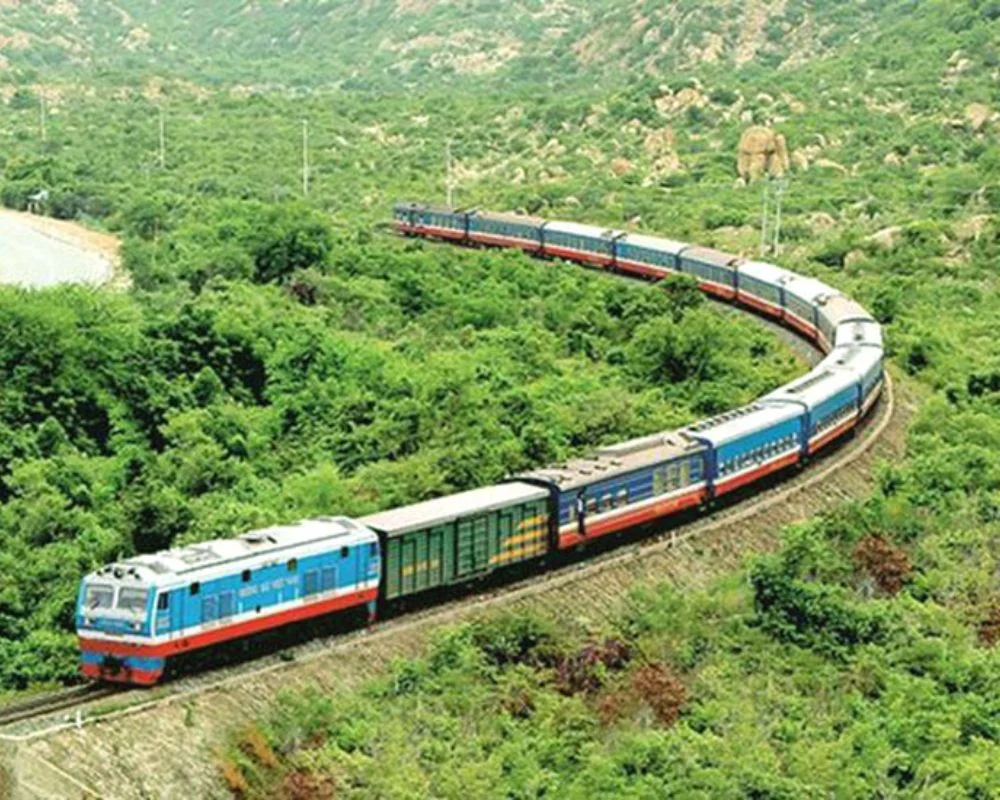
Knowing how to get to Sapa helps us plan better. Whether by bus, train, or motorbike, the trip offers unique experiences and stunning views.
Best Time to Visit Sapa Town
Choosing the right time to visit Sapa can make our trip unforgettable. Knowing the weather and tourist seasons helps us plan better. This way, we can enjoy Sapa to the fullest.
Seasonal Weather Patterns
Sapa’s weather changes with the seasons, making each time unique. The best times are spring (March to May) and fall (September to November). Spring is mild, perfect for outdoor fun and flower viewing. Autumn is great for photos of the golden rice terraces.
Summer brings warmer weather and rain, making it cooler than the lowlands. Winter is cold, with snow, creating a magical atmosphere for adventurers.
Peak Tourist Seasons
The summer months (June to August) are the busiest in Sapa. This means higher prices for places to stay and tours. But, the off-peak season from November to March is quieter and cheaper.
For the best trekking, visit in March to April or September to October. The Harvest and Watering seasons offer special experiences. Wearing the right clothes is key to enjoying the weather.
| Season | Temperature Range | Conditions | Best Activities |
|---|---|---|---|
| Spring (March – May) | 10°C – 20°C | Mild and pleasant | Trekking, sightseeing |
| Summer (June – August) | 17°C – 24°C | Warm with heavy rainfall | Cooler refuge from lowlands |
| Autumn (September – November) | 10°C – 20°C | Cool with clear days | Photographing rice terraces |
| Winter (December – February) | 0°C – 10°C | Cold with occasional snow | Snow activities, sunrise views |
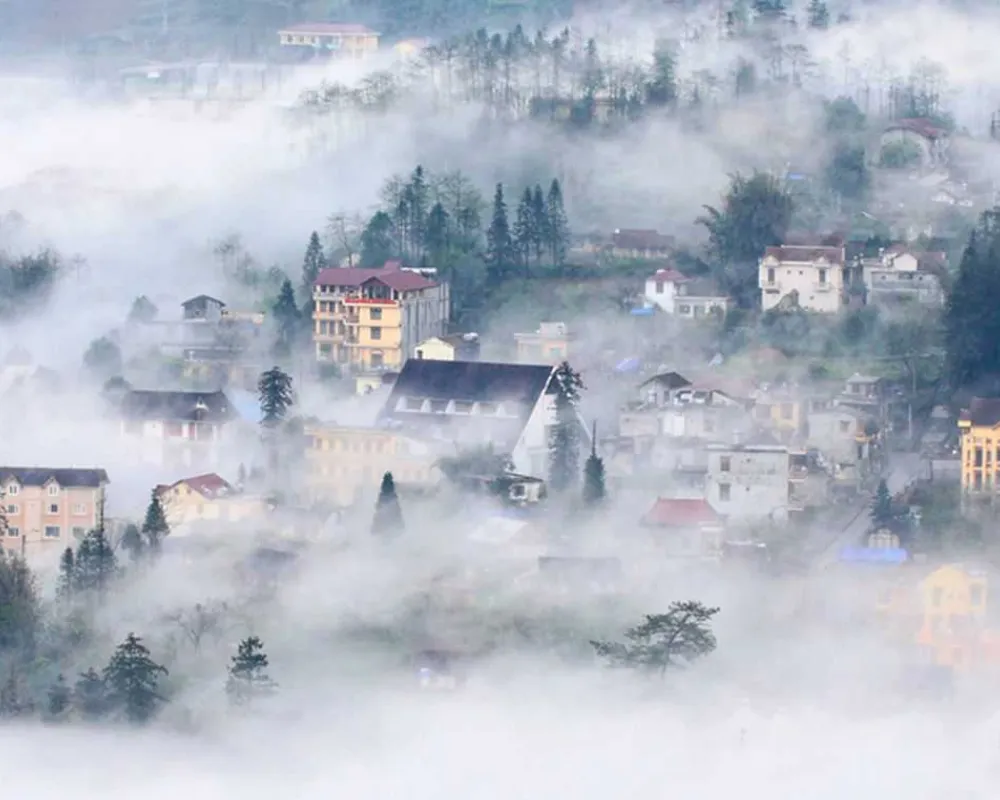
Top Attractions in Sapa
Sapa is full of amazing Sapa attractions that show off its natural beauty and culture. Fansipan Mountain is a must-see, being Vietnam’s highest peak. It offers stunning views for those brave enough to reach the top. The cable car ride there is an adventure not to be missed, costing about 1,100,000 VND for adults.
Cat Cat Village is another highlight, known for its Hmong culture. We can explore its trails, see traditional crafts, and enjoy the local waterfalls. For a thrilling experience, Dragon Waterfall in Hoang Lien National Park is perfect for a refreshing dive.
For peace, the Sau Chua rose garden is just 7km from Sapa’s center. It’s a lovely place to relax among the roses. The Glass Bridge also offers a unique view, with panoramic views of the green surroundings.
The ancient Ta Phin Monastery, about 12km east of Sapa, is a spiritual gem. It lets visitors connect with the area’s spiritual heritage while enjoying the mountain views.
Sapa has many things to do, like exploring Love Market or hiking up Ham Rong Mountain. Whether we visit Quang Truong Square or trek on Tram Ton Pass, Sapa always has something new to discover. For more on Sapa’s beauty, check out this detailed guide.

Exploring Sapa Town and Its Allure
To truly immerse ourselves in Sapa, we must explore Sapa town and dive into its vibrant culture. The local markets in Sapa are a highlight, offering a glimpse into the traditions of the region’s ethnic groups. Each market is a colorful, lively place, promising an unforgettable adventure.
Local Markets and Cultural Experiences
The weekend markets in Sapa are lively hubs where we can meet locals and see their handcrafted items. For example, the Bac Ha Market is open every Sunday, showcasing a mix of fresh produce, textiles, and handicrafts. It’s a bustling place where we can connect with the Hmong, Dao, and Tay people.
Daily visitors can check out Sapa Town Market, which has a wide range of goods. In the evenings, the Night Market opens from 6:00 PM to 10:00 PM. It’s a great place for exploring local street food and unique items.
Other markets in Sapa include the Love Market and the Sin Cheng Market. The Love Market is a charming Saturday evening event, while the Sin Cheng Market is in Sin Cheng Commune and open every Wednesday. For more adventure, we can visit Can Cau Market on Saturdays or Coc Ly Market on Tuesdays. Each market offers a unique atmosphere and a chance to connect with the local community.
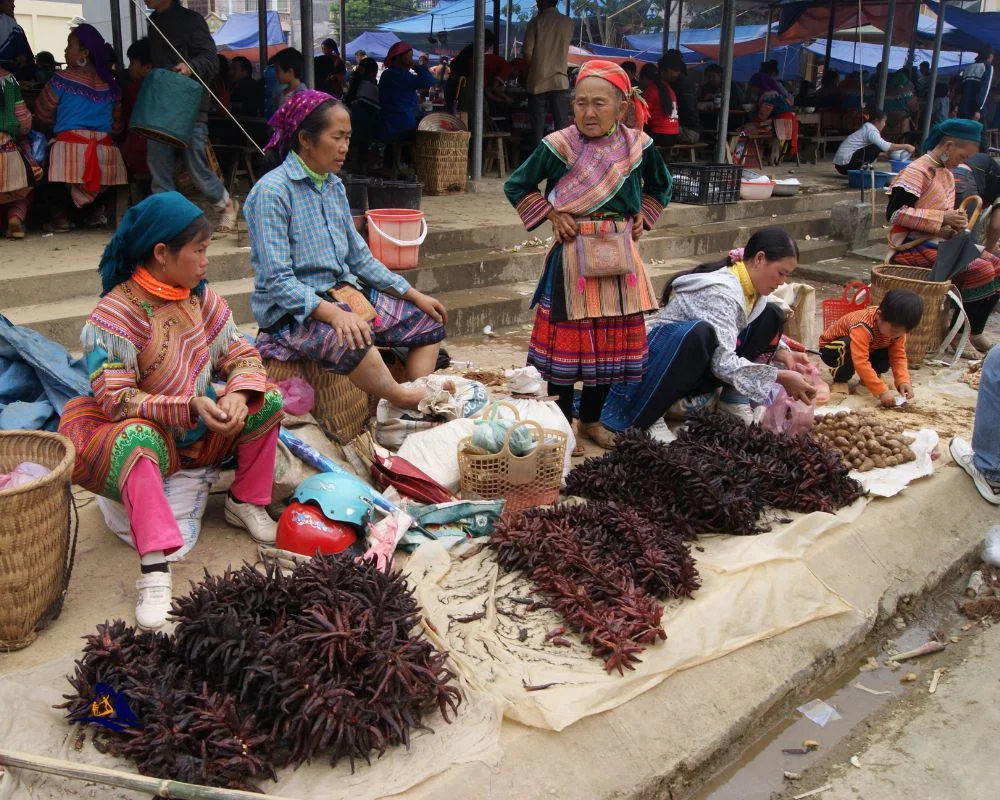
| Market Name | Location | Operating Days | Main Attractions |
|---|---|---|---|
| Bac Ha Market | Bac Ha District | Every Sunday | Textiles, handicrafts |
| Sapa Town Market | Lao Cai Province | Open Daily | Variety of goods |
| Love Market | Sapa Town | Every Saturday Evening | Cultural experiences, local music |
| Sin Cheng Market | Sin Cheng Commune | Every Wednesday | Local produce, cultural exchanges |
| Muong Hum Market | Bat Xat District | Every Sunday | Unique handicrafts |
| Coc Ly Market | Bac Ha District | Every Tuesday | Livestock trading |
| Cao Son Market | Muong Khuong District | Every Wednesday | Ethnic diversity, local products |
| Can Cau Market | Si Ma Cai District | Every Saturday | Lively livestock trading |
| Lung Khau Nhin Market | Muong Khuong District | Every Thursday | Highland products |
As we explore these markets, we hear stories and make friends, deepening our understanding of Sapa’s culture. Each visit shows the area’s vibrant market life and the traditions that have lasted for generations. Our journey in Sapa is a testament to the spirit of its people.
Trekking and Outdoor Adventures in Sapa
Sapa is a paradise for outdoor lovers, especially those who enjoy trekking. It has many trails for all kinds of adventurers. You can take easy walks through rice paddies or tackle tough climbs like Mount Fansipan.

The trails in Sapa are breathtaking. As we walk, we see beautiful fields and villages. We also meet the local ethnic minorities, like the H’Mong and Dao people. Sharing meals and learning about their culture are unforgettable experiences.
Trekking in Sapa has been popular since the early 1900s. The 1990s saw a big increase in tourism. Travel agencies in Hanoi’s Old Quarter offer Sapa hiking tours for about $100. These tours include homestays or local hotels and day treks.
| Activity | Description | Average Cost (USD) |
|---|---|---|
| Trekking Tour | Guided hiking experiences ranging from easy walks to challenging treks. | 100 |
| Homestay | Stay with local families to immerse in cultural practices. | Variable* |
| Sapa Hotels | Comfortable accommodation options with beautiful mountain views. | Variable* |
| Transport Options | Bus, train, private car, or motorbike rental to reach Sapa. | Variable* |
Sapa offers amazing views, friendship, and a deep connection with nature. Whether you’re looking for peace or excitement, Sapa is the perfect place to explore.
Understanding the Ethnic Diversity of Sapa
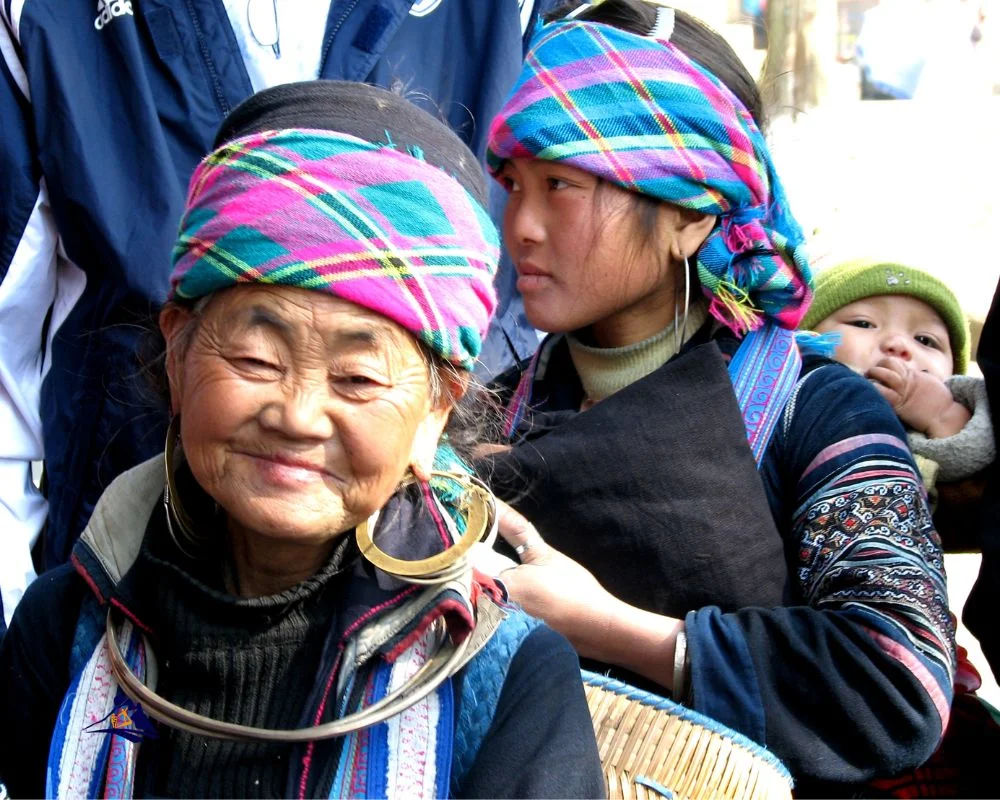
Sapa is a lively example of ethnic diversity. It’s home to groups like the H’Mông, Dao, and Giay. Each group brings its own traditions, languages, and crafts to the area.
The H’Mông people make up 52% of the population, with the Dao at 25%. The Tày and Giay groups are smaller, but still important. The Xá Phó, though less known, also enriches Sapa’s cultural scene.
Community markets, like the Bac Ha Market, are full of life. They offer everything from handicrafts to traditional clothes. Local festivals give us a glimpse into the unique celebrations of these groups.
Traditional costumes are key to each group’s identity. They show off different styles and craftsmanship. These customs help visitors connect with the local culture.
| Ethnic Group | Percentage in Sapa Region | Key Characteristics |
|---|---|---|
| H’Mông | 52% | Known for colorful attire and intricate silver jewelry. |
| Dao | 25% | Recognized for their elaborate headdresses and medicinal knowledge. |
| Tày | 5% | Famous for their traditional Long Tong Festival. |
| Giay | 2% | Noted for unique weaving techniques and rice cultivation. |
| Xá Phó | Less than 1% | Least visited ethnic group in Sapa, with distinct folk ways. |
Exploring Sapa’s culture lets us see its rich ethnic diversity. It helps us understand Vietnam’s diverse cultural landscape better.
Sapa’s Cultural Heritage and Local Traditions
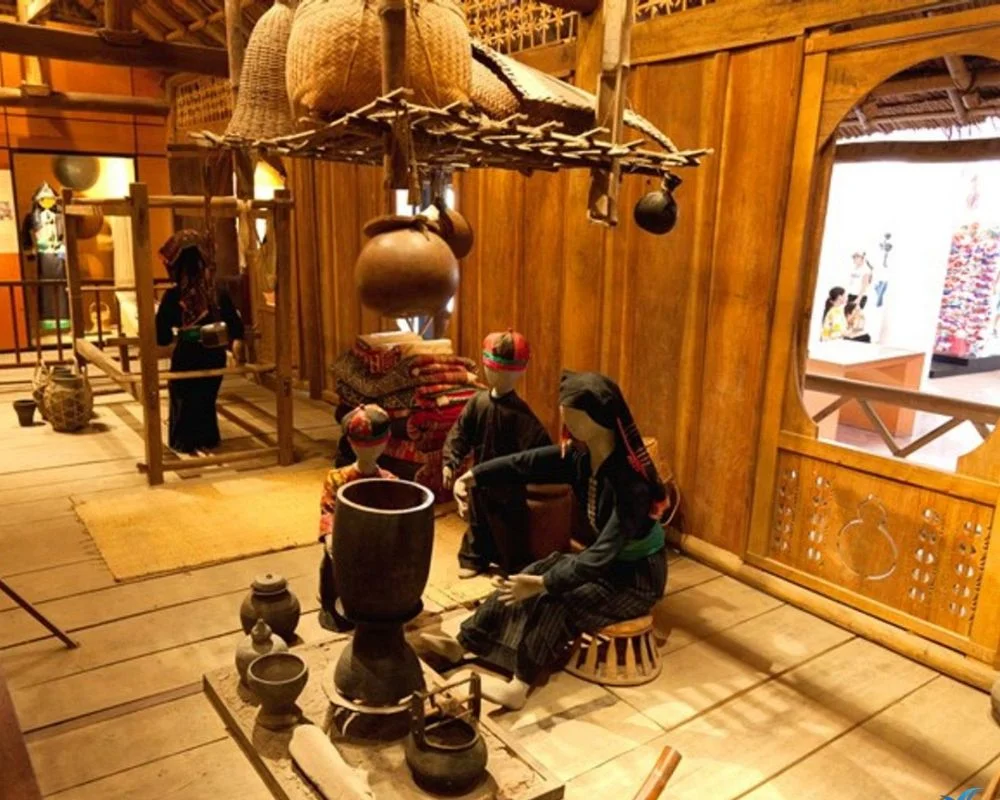
Sapa’s culture is a mix of many traditions, thanks to its diverse ethnic groups. These traditions are seen in the rituals and crafts of the area. They show the history and learning of the people.
The Sapa Culture Museum is a key place to learn about these traditions. It opened in 2007, thanks to a partnership between Lao Cai province and France. It has over 200 artifacts that show the cultures of Sapa’s ethnic groups.
Visiting the museum’s gift shop lets us see local handicrafts. We can even try on traditional costumes from groups like the H’Mong and Red Dao. This makes us understand Sapa’s heritage better.
The museum uses multimedia to tell the stories of Sapa’s ethnic minorities. We see farming tools and religious items. This shows us the traditions that shape the community today.
Exploring Sapa’s culture, we see traditions celebrated in festivals and crafts. Every experience connects us to Sapa’s heart. It shows a place that is not just beautiful but also rich in heritage.
Activities and Experiences You Can’t Miss in Sapa
Sapa is full of activities that connect us with its beautiful landscape and culture. Trekking is a top choice, offering 1 to 3-day treks through stunning fields, valleys, and villages. It costs about USD 20-40 per day, making it a great adventure.
- Visit Local Markets: Local markets let us meet the people and buy unique crafts.
- Taste Traditional Cuisine: Try dishes like thang co, a horse meat stew, or salmon hot pot, perfect for sharing.
- Experience a Herbal Bath: A Red Dao herbal bath refreshes the body and shows off cultural traditions.
- Explore Waterfalls: Visit Love Waterfall or Silver Waterfall for beautiful views.
- Cable Car to Fansipan: The cable car ride to Fansipan Mountain offers amazing views of Sapa.
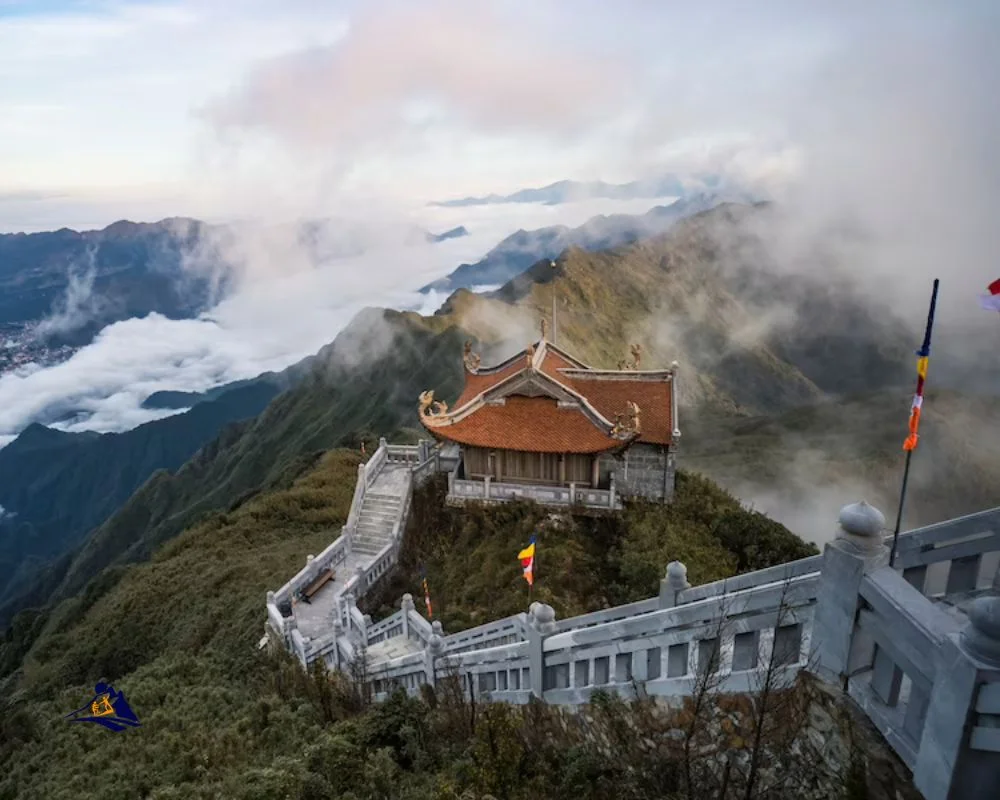
Staying in Sapa for 2-3 days is ideal to enjoy these experiences. There are many affordable activities for all. Whether trekking, trying local food, or exploring culture, Sapa leaves unforgettable memories.
| Activity | Cost (VND) | Description |
|---|---|---|
| Trekking | 20,000 – 40,000 (USD) | Explore stunning landscapes and local villages over 1-3 days. |
| Cable Car to Fansipan | 800,000 | Enjoy panoramic views from the highest mountain in Vietnam. |
| Herbal Bath | Varies | Relax while immersing in traditional herbs used by the Red Dao community. |
| Love Waterfall | 250,000 | Motorbike ride to the picturesque waterfall with stunning surroundings. |
| Entry Fee to Cat Cat Village | 70,000 | Experience the beauty of this hill tribe village and its unique culture. |
Recommended Accommodations for Travelers
Sapa offers a wide range of places to stay, fitting every traveler’s needs. Whether you’re looking for something affordable or a luxurious retreat, Sapa has it all. Budget travelers can find stays for as little as $3 per night, perfect for backpackers.
For those seeking luxury, the Hôtel de la Coupole – MGallery is a top choice. It combines Sapa’s charm with modern comforts. Mid-range options like Le Boutique Hotel offer cozy stays and great service.
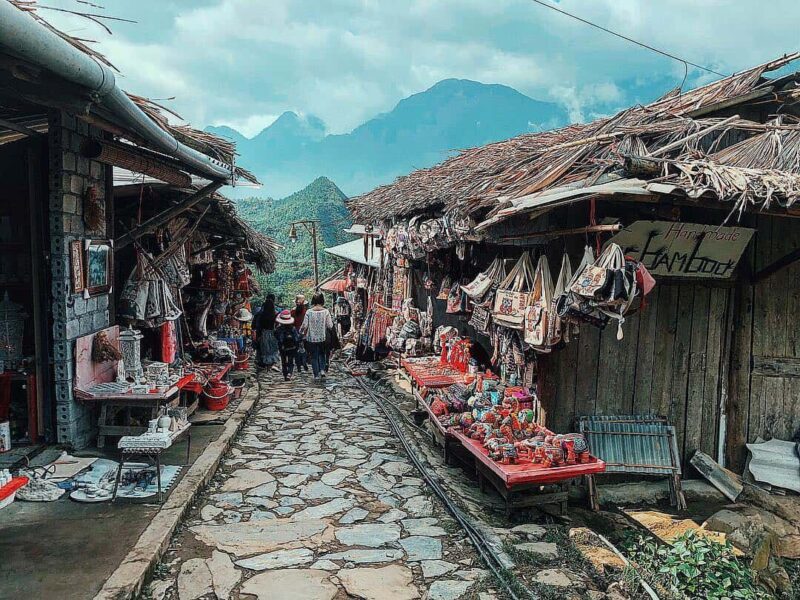
Staying in a homestay lets you dive into local culture. Homestays in Cat Cat Village and Ta Van Village offer traditional homes with stunning views. Favorites include Youth Homestay Sapa and Sapa Clay House for their beauty and hospitality.
Ecolodges like Topas Ecolodge and Sapa Laxsik Ecolodge offer luxury and eco-friendliness. They let you enjoy your stay while helping preserve Sapa’s nature.
The town’s walkable layout makes it easy to explore markets and attractions. With so many options, you can tailor your stay to make unforgettable memories.
Sapa’s Unique Culinary Scene
Sapa’s food scene is a mix of flavors from different ethnic groups. We can enjoy local dishes that show off Sapa’s culture.
Thang Co is a famous dish made with horse meat and herbs. It’s a must-try for real Sapa food. Com Lam, sticky rice in bamboo, is also popular in markets and stalls.
- Grilled stream fish (ca suoi nuong) – A delicious dish with local fish.
- Cap-nach pork (thit lon cap nach) – A tasty pork dish from Sapa’s mountains.
- Salmon and sturgeon hotpot (lau ca tam) – A hotpot with fish and rice noodles.
- Five-colored sticky rice (xoi ngu sac) – A colorful rice dish.
Sapa uses special ingredients like mam da vegetable and black chicken. We can also enjoy roasted chestnuts and chestnut cake.
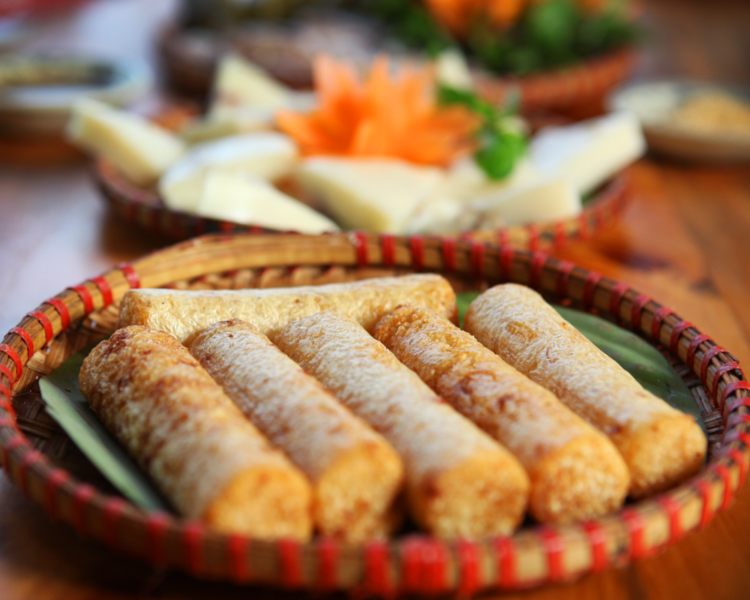
| Dish Name | Description |
|---|---|
| Thang Co | An aromatic horse meat soup slow-cooked with herbs and spices. |
| Com Lam | Sticky rice cooked in bamboo tubes, often served with meats. |
| Dried Buffalo Meat | A chewy snack enjoyed with rich umami flavor. |
| Men Men | Noodle soup made with rice flour noodles, served with pork or chicken. |
| Wild Vegetables | Seasonal greens foraged freshly from Sapa’s slopes. |
From night markets to cozy eateries, Sapa’s food is amazing. Each dish lets us enjoy the moment and connect with Sapa’s food culture. Whether it’s a fancy meal or street food, Sapa’s food is a treat for the senses.
Conclusion
Sapa, Vietnam, truly captures the heart of every visitor. Its stunning landscapes, from the rice terraces of Muong Hoa Valley to Mount Fansipan, are perfect for adventures. The local markets and festivals also show the rich culture of Sapa’s communities.
Exploring Sapa is more than just outdoor fun. It’s about trekking through villages and trying local foods. It’s also about meeting the diverse ethnic groups that live here. Whether it’s spring or autumn, Sapa offers unforgettable experiences.
Sapa is a special place for nature and culture lovers. As we look forward to our next visit, let’s hold onto the memories and friendships made here. It’s a hidden gem that we can’t wait to explore again.
Sapa 1 Day Tours

- 1 day experience
- Moderate to challenging
- Cultural immersion & active adventure
- Rice fields, valleys & villages
- Private tours
- Vegan-friendly
Sapa 2 Day Tours

- 2 days 1 night experience
- Moderate to challenging
- Cultural immersion & active adventure
- Mountains, valleys, rice fields and villages
- Private tours
- Vegan-friendly
Sapa 3 Day Tours

- 3 days 2 night experience
- Moderate to challenging
- Cultural immersion & active adventure
- Mountains, valley, rice fields & villages
- Private tours
- Vegan-friendly
Sapa 4 Day Tours

- 4 days 3 night experience
- Moderate to challenging
- Cultural immersion & active adventure
- Mountains, valleys, rice fields & villages
- Private tours – Less Touristic
- Vegan-friendly
